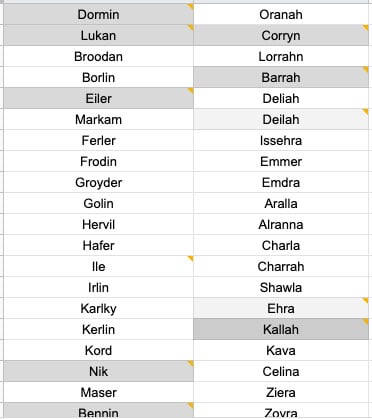- First Name и Last Name — что это значит? Что писать то?
- Как правильно указывать имя и фамилию?
- Middle Name — что означает?
- Character Names: 19 Methods & Tips for Naming Characters Step-by-Step
- Naming Characters Intentionally: Why Character Names Matter
- Character Name Generators
- How to Come Up With Character Names
- #1 – Baby Name Websites
- #2 – Root-Meaning Method
- #3 – The Mash-Up
- Here’s the step-by-step breakdown for how to create simple character names with this method:
- #4 – The Add-On
- Here’s what this looks like…
- #5 – Develop-First Naming
- #6 – Make Them Up
- Here’s how you can replicate this process:
- #7 – Name-by-era
- #8 – Using similar but different real names
- Top Tips for Naming Characters in Your Book
First Name и Last Name — что это значит? Что писать то?

В общем когда вы что-то оформляете, то вам нужно заполнить бумажный или электронный документ, и вот там может быть поле First Name.
Еще раз — в поле First Name мы просто пишем имя и все. Не фамилия.
А что тогда писать в Last Name? А тут уже нужно писать фамилию. Если перевести дословно Last Name, то будет что-то типа последнее имя — это и имеется ввиду фамилия. Хотя согласен, что немного непонятно все это..
First Name и Last Name — перевод на русский:
Вместо Last Name также может быть Family Name:
Вы можете встретить еще такое поле как Surname last name — это еще что такое? Как я понимаю, то если пишется именно так, то это тоже имеется ввиду фамилия. А вообще запутаться можно в это всем..
Как правильно указывать имя и фамилию?
Но это еще не вся сложность, с которой вы можете столкнуться. Смотрите, вот вы уже поняли, куда нужно писать имя и куда фамилия. Но как писать? Дело в том, что вас могут попросить писать не русскими буквами, а английскими.
Вы можете подумать — ну что тут сложного, напишу английскими буквами. Но нет, постойте, дело в том что есть что-то вроде.. в общем есть некая официальная транслитерация. В общем там какие-то правила, не знаю, но важно указывать правильно имя и фамилию даже если английскими буквами.
Вот смотрите, меня зовут Дмитрий Шариков, и вот я нашел в интернете сайт, где есть официальная транслитерация с русского на английский (даже по ГОСТу какому-то), и там написал свое имя и нажимаю кнопку Транслитерировать (слово просто ужс):
И вот результат:
То есть видите, вроде бы просто — но есть еще какие-то правила, стандарт ГОСТ какой-то..
Сайт, на котором я это все делал — вы бес труда найдете в Яндексе, писать его не буду, а то будет как бы реклама. Есть и другие сайты, но я нашел этот, он был на первом месте и вроде бы неплохой)
Примеры полей First Name и Last Name — заполняйте внимательно!


Middle Name — что означает?
Но есть еще такое как Middle Name — что это такое? А вот это интересно, я даже и не знал, но.. в некоторых странах дают еще одно имя. То есть у человека может быть два имя! И для второго имени и придуман поле Middle Name.
А вот перевод на русский Middle Name:
Если у вас нет имени второго, то Middle Name заполнять не нужно. Также там где вы заполняете, там может быть галочка возле Middle Name, она может активировать или деактировать поле.
Поле Middle Name


Так, вот еще важная информация по поводу Middle Name. Многие сюда пишут отчество, в то время как поле предназначено для второго имени (на западе такое распространено). Но на самом деле Middle Name и отчество — разные как бы вещи. И еще вроде бы.. как.. в Middle Name нужно писать то, что написано в загранпаспорте, если он у вас есть. В общем вот вам подсказка на эту тему:
- Осторожно заполняйте поля, пишите правильно, если нужно английскими буквами — то используйте какой-то популярный сервис перевода русских слов в транслит.
- Если вы заполняете документ в каком-то офисе или учреждении, то спросите там рядом, как и что заполнять. Лучше спросить, чем потом получить отказ из-за одной неправильной буквы, особенно когда это банковские документы.
На этом все. Удачи вам и пусть у вас все получится.
Источник
Character Names: 19 Methods & Tips for Naming Characters Step-by-Step
Your character names have the ability to transform the perception readers have of your book and story.
If you think about it…character names are actually a specific literary device you can use most sneakily.
And if you want readers to love, adore, and care for your main character, giving them the best and most memorable name can make all the difference.
Use these methods for naming characters in your book:
Character Development Cheat Sheet [also printable!]
Fast track your character development in HALF the time.
Keep your characters feeling REAL and organized at the same time with a fully customizable and printable character development worksheet designed to make your characters shine!
Naming Characters Intentionally: Why Character Names Matter
Character names have the power to transform your reader’s perception of your character entirely.
Let’s use the example of names from How to Train Your Dragon, the animated film.
Character name example: Hiccup
Why this character name matters: This name is extremely fitting to the type of character Hiccup is. The reason for a silly, “weak” name like this is because that is what the creators want you to think of when you hear the name. They want you to have low expectations so that when this character rises above, the emotional impact is far greater than if he had a typical “hero” name.
You can use this same ideology for villains. One in particular with a famous name is from Harry Potter.
Character name example: Lord Voldemort
Why this character name matters: From the beginning, Rowling crafted this name to be foreboding. In fact, this character himself chose the name because of that. As the author, you can craft your villain’s name based on your intentions. If you want readers to underestimate them, choose a silly name like Bob. But if you want readers to fear the wrath of your villain, choose a more fitting name like Lord Voldemort.
Character Name Generators
If you’re looking for the easy way out and would rather someone else do the work in naming your characters, there are tools online for that.
Here are some of the top character name generators:
- Character Name Generator – This one allows you to fill in several different defining factors in order to produce a character name that fits your character best.
- Fantasy Name Generator – Are you writing a fantasy novel and need some character name ideas? This generator offers several different options for theme-based character names for your fantasy book.
- Name Generator for Fun – With this one, you can choose from several categories, like villain names, rap names, superhero names, and more.
- Name Generator – This character name generator also gives you options to narrow in on details about your character for a more fitting name. However, this one has more real-life names than uniquely created, so it may serve better if you’re writing in the contemporary book genre.
- Writer’s Character Name Generator – While very random, this one may just allow you to stumble upon your next main character’s name.
How to Come Up With Character Names
Naming your characters is one of the best and scariest parts of writing a novel.
Using one of these methods will help ease the process while providing higher quality final results.
#1 – Baby Name Websites
One of the most popular methods of coming up with new character names is to pretend they’re your baby…literally!
Baby naming websites have been serving up characer names for writers for years.
Oftentimes, these websites even offer name meanings, trending names, and even names that were popular doing different years.
Here are some great baby name websites to discover your characters’ names:
#2 – Root-Meaning Method
Welcome to the most common, tried-and-true method to name characters in books.
People use this method in real-life to name their children, too!
The root-meaning method simply refers to using a core meaning or belief or even origin of a name for symbolism in your book.
Here are some examples of this:
- Tobias Kaya inThe Savior’s Champion:His name means “goodness” and is very much meant to align with who his character is and his role in the series.
- Frodo Baggins inLord of the Rings:Little do most people know, the name Frodo originated from the old English word “fród,” which translates to “wise by experience.”
- Katniss Everdeen inHunger Games:This book’s author really took the name meaning seriously when crafting her main character. Katniss is a plant in the genus Sagittaria, which roughly translates from Latin as “archer.”
You can easily find the meanings of names by venturing to baby naming websites. You can also type in a name you like to Google and it will usually pop up.
#3 – The Mash-Up
One of my personal favorite ways of creating new names is to simply mash real-life names together until I find something that’s real-sounding but also unique to my world and characters.
This method of coming up with character names is better learned through seeing than a simple explanation:
Josh and Riley = Joley, Jile, Rosh, Rishe
Casey and Michael = Cachel, Cachael, Casel, Misey, Miche, Michey, Masey
Emily and Rochelle = Emelle, Echelle, Romil, Romily, Rochil, Rocily
Obviously, some combinations will be better than others, but this is a quick way to generate new but realistic character names.
Here’s the step-by-step breakdown for how to create simple character names with this method:
- Choose or find 2 real-life names
- Match them side by side
- Take the first half of the first name and mix and mach it with the last half of the second name
- Repeat step 3 but vice versa
- You should have a list of several different sounding names
- Choose a few to keep that you like
- Repeat this process with several pairs until you have a roster of character names to choose from
#4 – The Add-On
This method is super similar to the previous method but with more freedom.
This is another personal favorite and how I manage to come up with cool and interesting names that are also unique to my story.
Instead of taking two names and matching the beginning of one with the end of the other, simply choose real names and swap out the endings or add on to them completely.
Here’s what this looks like…
Rebecca = Rebera, Rebilla, Rebyr, Rebine, Reborra
Taylor = Tayr, Tayora, Tayrin, Taysila, Tayserra
Cory = Corrin, Corel, Coreesa, Coryn, Corros, Cortsa, Corta
John = Johva, Johrrin, Johk, Johrey
The steps for this one are pretty obvious. Choose a random real-life name and simply swap out the endings for a combination you create on your own.
I always try to do varying combinations, remembering that double consonants work well, as does changing the length of the vowel sounds by adding or changing those letters.
I do this often and keep a spreadsheet with names I like, as in the image below.
#5 – Develop-First Naming
Sometimes choosing a character’s name too early will make you subconsciously develop that character into someone who fits that name.
This can be bad if you need that specific character to act and behave in a certain way.
With this character naming method, you will develop your character in full first and then choose their name. The reason for this is to ensure you’ll write that character with intention.
For example: in the Harry Potter series, the mood tends to be more serious. Rowling created Ron Weasley as comedic relief. While Ron is much more than that, the intention is still for him to be a goofy, funny character.
The name “Ron Weasley” supports this development.
Had she named him a more serious name like Reginald, Theodore, or Christopher, crafting those scenes may have been very different.
The same can be said for another character called Draco Malfoy. This name is far more dark than it is funny, which is fitting for his character.
The steps for this character naming method are simple:
- Download and fill out this character development worksheet.
- Understand your character’s role in the story. Do you want them to be serious, funny, silly, foreboding?
- List names that make you feel the way of your intentions.
- Ask friend and family to tell you what each name makes them think of personality-wise.
- Narrow down your choices to 3 and ask another group.
- Decide on the best-fitting name.
#6 – Make Them Up
If you want to have 100% unique character names (like Lhonniadreah, a character in the book I’m writing, Lhonni for short), you’ve got to get creative.
But you’re a writer, so you know how to get creative.
This particular method doesn’t have many rules.
Essentially, you can simply think up a random name. Perhaps you have a base or a beginning that you like.
For example, my full original name for the character mentioned above was Lhonni. But I felt her character needed a longer name to fit with the traditional style of the names in her culture.
Secondly, I decided to pull from the common letter match-ups this culture sees often. In this case, the combinations of the “dr” sound with long vowels is popular.
I went on to create several combinations of potential full names:
- Lhonnidray
- Lhonniyadra
- Lhonniodrin
- Lhonnidra
Ultimately, the name I chose best fit her as a character, and I decided afterward that her mother’s name would be “Dreah,” so that her name is a namesake that’s in common format for the culture I created.
Here’s how you can replicate this process:
- Write down a sound or start or end of a name you like (this can be a “-ly” ending, an “ash-” beginning, or even an “-eer-” middle of a name.
- Decide if you want the name to hold any significant meaning the way mine does. This does not have to be the same meaning. You can even find base words in English or Latin to use.
- Take into account any world-specific cultural influences on the name. Your world building expands to even your character’s name. Don’t forget this! (If your book takes place in this world, think about family spellings and such as a substitute)
- Create a list with several different versions and variations. Remember your character’s name can take on very different meanings and intentions based on the sound (and look!) of it.
- Choose the name thatfeelsright and embodies your intentions for the character. And let it stew for a few days! Now, even if your character is brave and strong, like in the Hiccup example, using a less-than-obvious name can provide a unique perception that fosters a better reaction later.
#7 – Name-by-era
One of the biggest mistakes you can make is unintentionally destroying your reader’s suspension of disbelief by naming a character something wildly out of the ordinary for a time period.
If you’re writing historical fiction or just a story from 10-15 years ago, you want to make sure your names are realistic for the time period.
This trick is also helpful if you want to give your out-of-the-real-world novel a specific time era vibe.
Here are some resources for baby names by era:
#8 – Using similar but different real names
The most famous author who uses this method is George R.R. Martin in his infamous series Game of Thrones.
What Martin did in order to give this epic fantasy series realistic but medieval sounding names is simply alter just a few letters in a name.
Here are some examples of names from Game of Thrones with more common real names:
- Gregor — Gregory
- Joffrey — Jeffery
- Brienne — Brianne
- Theon — Theo / Theodore
- Petyr — Peter
- Jorah — Jonah
- Gilly — Lilly
- Podrick — Rodrick
Martin has a way of completely transforming these very similar-to-real-life names into something with both a. fantastical and medieval twist in order to further transport us to his world.
Of course Game of Thrones also features completely unique names like Daenerys and Tyrion along with real-life names like Robert and Jon. Martin uses this combination to his advantage—and you can too!
Top Tips for Naming Characters in Your Book
No matter which method you choose for naming your characters, you’ll need a few tips to make it more effective.
Here are the best tips for naming book characters with intention.
Character Development Cheat Sheet [also printable!]
Fast track your character development in HALF the time.
Keep your characters feeling REAL and organized at the same time with a fully customizable and printable character development worksheet designed to make your characters shine!
Источник






















